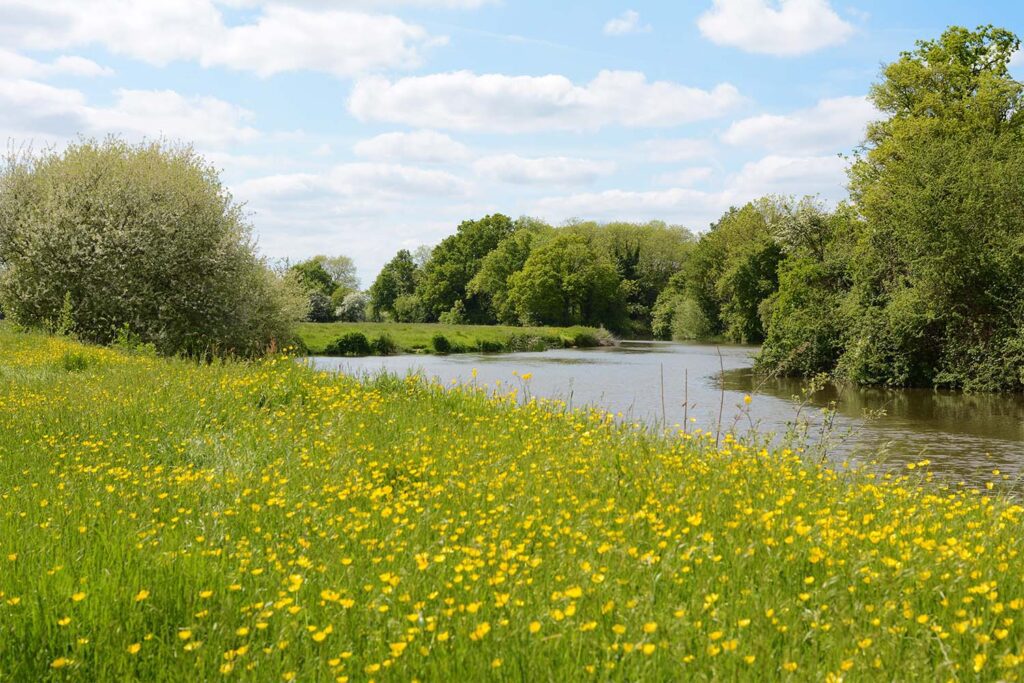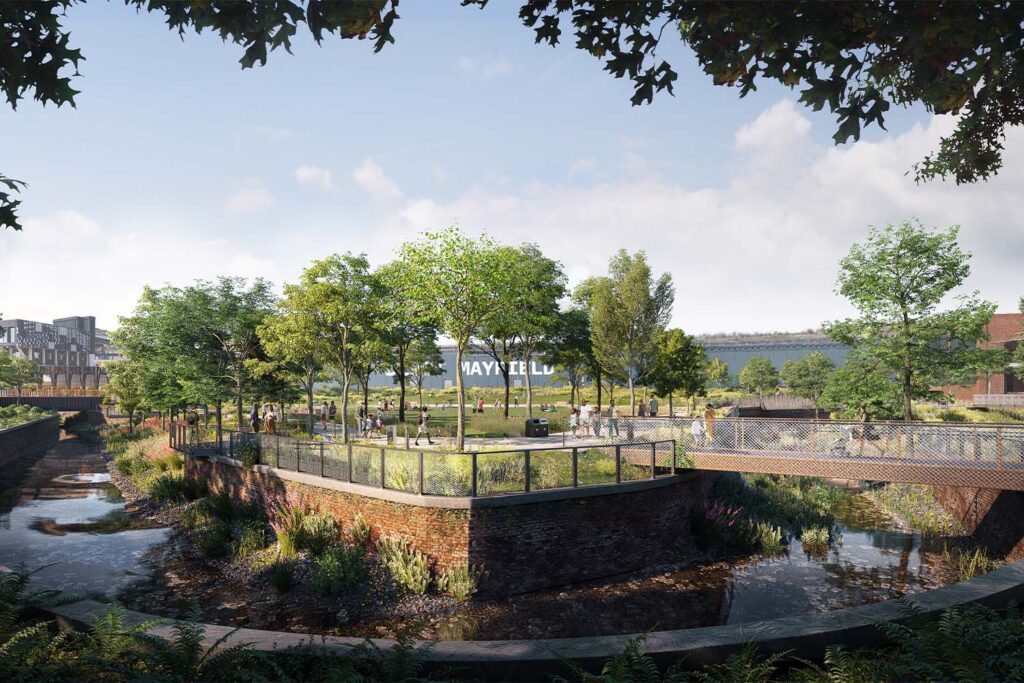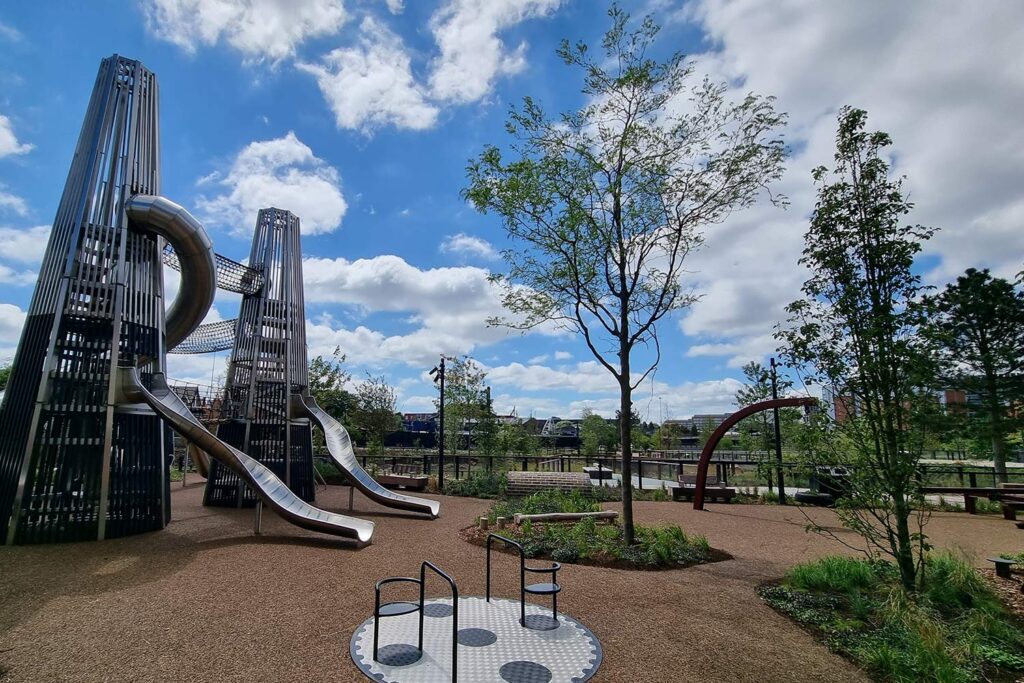Climate resilience and nature-based solutions
How the built environment addresses the impacts of the climate crisis is a complex picture, but one that can begin to be untangled by using nature. In this article, learn how ‘nature-based solutions’ can support the delivery of a necessary degree of climate resilience.
The need for climate resilience
The impacts of the climate crisis are clear, with an alarming swathe of impacts and problems, in all corners of the world. From increased levels of flooding and wildfires, displaced people, urban infrastructure impact, consistently record-breaking high temperatures and heat stresses, and food and water insecurity, the climate crisis is causing a wide range of environmental, social and economic shocks.
The global built environment is a vast sector, and therefore has an impact on the climate. Because of this, mitigations from within the built environment have great potential in playing a positive part in dealing with problems caused by the climate emergency. Work to decarbonise buildings and associated ecosystems is no longer a ‘nice-to-have’, it is business as usual.
Buro Happold, and the wider built environment sector, plays a role in helping to curb emissions and prepare for supporting global approaches to climate change. A critical one is the idea of climate resilience and adaptation.
Climate resilience is the capacity to anticipate, withstand and cope with the shocks and impacts caused by the climate crisis on our social and economic systems. Sabrina Bornstein is a principal in our Los Angeles office and Buro Happold’s regional discipline leader for cities, specialising in climate resilience work. She said, “The 100 Resilient Cities Network considers climate resilience as the ability to survive, adapt and thrive in the face of chronic stresses and acute shocks.

“While mitigation efforts and decarbonisation work must also happen to slow down and reduce frequency of higher temperatures and more extreme weather events, climate resilience work looks more closely at the impacts and how the world must adapt.”
The ongoing decline and destruction of biodiverse habitats should also be considered as an integral part of climate resilience discussions. The climate crisis and global biodiversity crisis are inextricably linked.
So, how can built environment professionals ensure long term value and create safe, flourishing communities and ecosystems through our work? How the built environment becomes more resilient is a complex question, with a complex answer.
There are many factors to consider in how this can be achieved and requires inter-disciplinary work. No single set of specialists can provide a comprehensive way to become resilient to climate changes. One area that should receive more attention is the idea of utilising nature to help us. This is known as ‘nature-based solutions.’
Nature-based solutions
So, what are “nature-based solutions”? The name gives the game away. Nature-based solutions are part of a wider suite of options that allow the built environment to be more resilient in the face of climate change; it is a broad term that refers to any intervention that uses the power of nature to provide solutions to a problem.
It is a collection of approaches to using nature in our work, with outcomes that include protecting environments against the effects of climate change, while addressing the problem of global biodiversity decline – two fundamentally intertwined problems. There are also many secondary benefits, such as the human health and wellbeing advantages, the afore mentioned bolstering of biodiverse habitats and impacts on energy use and costs.
These solutions differ depending on the context. Broadly, we can consider some key practical interventions such as green roofs and walls, planting of trees, rain gardens and new wetlands in cities (these can also play a role in temperature management and mitigation against the urban heat island effect).

Outside of cities, carbon sinks such as forests and biodiverse planting play a critical role in sequestering carbon emissions. The establishment of new green spaces in urban environments, the restoration of previously modified habitats and the avoidance of deforestation and habitat degradation of existing ecosystems, is key in this.
Jenny Ross is associate ecologist at Buro Happold. She said, “By harnessing nature-based solutions, we are reducing risk for ourselves, but also for nature. There’s a big link between climate change and biodiversity loss. Both are significant issues, and both need to be addressed together; we can’t fix one without the other.
“Nature-based solutions can support both; they are extremely useful tools for ecologists to harness and are a way to demonstrate the value of investing in nature and the benefits it can bring to clients. We are able to use them as part of the wider climate resilience conversation and can frame these biodiversity interventions on a site in terms of how they’ll be beneficial for the future.
“One of our targets is to ensure that when we are making recommendations as part of our standard assessments of looking at sites and seeing where the value is, we are highlighting to clients and others within Buro Happold how biodiversity interventions are part of a larger climate resilience picture.”
There’s a big link between climate change and biodiversity loss. Both are significant issues, and both need to be addressed together; we can’t fix one without the other
Jenny Ross, associate ecologist, Buro Happold.
What role does Buro Happold play in providing nature-based solutions?
Buro Happold’s work on the regeneration of Mayfield, in Manchester, UK, is a prime example of development of a – in this case, urban – site with nature-based solutions at its heart. Mayfield is a formerly derelict part of central Manchester that now hosts the first public park in the city for more than a century, with wider regenerative work around it – including upcoming homes, offices and leisure facilities.
The work of our ecology and biodiversity management team was a central part of this project. The positive effects of increased green spaces in cities include heat reduction/cooler environments, reduced air pollution, water management, and increased physical activity – with the health benefits that brings.

The idea of climate resilience is important to Mayfield. The park is on the banks of the River Medlock and our teams had the opportunity to support the restoration of the river section on site, using wetland and wet grassland landscaping at the points that were designed to accommodate flooding.
Other environmental benefits included mitigating pollution and sediment in run-off and improving biodiversity in and on the river. Space around the River Medlock provides the city of Manchester with necessary flood storage when the river levels are high. These flood zones, planted with trees, shrubs and other plants, also capture carbon.
Jenny Ross said, “Mayfield is a flagship example of our work and I’ve had conversations with other clients who have seen it and have been interested in doing similar kinds of work where they have highly modified watercourses on their site.
“Applying nature-based solutions to watercourses (such as re-naturalising rivers or allowing land to flood where appropriate), the water flow can be allowed to slow, rather than racing through the channel. This is something we implemented at Mayfield. This afforded us the opportunity to create wetland areas amongst the amenity park planting which increased plant diversity.
“This will have knock on benefits for invertebrates and bird species that need that kind of habitat to survive, as well as providing a greater variety of habitat mosaics within the site.”
As ecologists, it is now our job to demonstrate the knock-on effects of nature-based solutions, and the positive cascade of effects they can create. Wherever development happens, it is critical to factor in biodiversity and climate resilience from the very start
Jenny Ross, associate ecologist, Buro Happold.
Another impact of the climate crisis is rising sea levels, with risks to coastal communities. This is an area where nature can be used to provide solutions and ensure resilient, biodiverse coastal communities. Jenny Ross said, “Coastal habitats such as salt marshes, seagrass meadows and mangroves (in tropical climates) can absorb the energy of the sea and slow it down before it hits land. If those habitats are taken away or not developed, then the impacts of the sea and ocean on land will increase. Utilising nature to reduce these effects is very important.”
Simultaneous positive outcomes
Using nature to provide multiple, simultaneous positive outcomes is one of the impressive things about nature-based solutions. Jenny continued, “Using nature-based solutions in our work provides a twin effect: that of enhancements and provisions for biodiversity, coupled with the positive effects that has on humans. This is starting to get easier because there is a growing evidence base to support it; there are pioneers who can investigate and demonstrate benefits.
“Initiatives like the Ignition Project in Manchester studied nature-based solutions to define clear benefits such as energy saving and pollution removal from the air. This is important because the more evidence we get, the more we can use nature-based solutions to solve the problems that the climate emergency is causing. That is good for the planet, and from a business sense, good for our clients too.
“As ecologists, it is now our job to demonstrate the knock-on effects of nature-based solutions, and the positive cascade of effects they can create. Wherever development happens, it is critical to factor in biodiversity and climate resilience from the very start.”
What next?
There is no simple checklist of how or where to implement nature-based solutions. The work is complex and is always dependent on the site and the desired impact. But the ‘why’ element of the conversation is easy. The need for using as many tools as possible to build climate resilience at a time of crisis is self-evident. Nature-based solutions cannot provide all the climate resilient answers we need, but they can provide a key contribution.
The fact that nature-based solutions actively ameliorate against some impacts of the climate crisis, providing a net positive impact, is another reason why the built environment looks to nature to solve the problems that humans increasingly cause.
Learn more about our ecology and biodiversity management services here.


